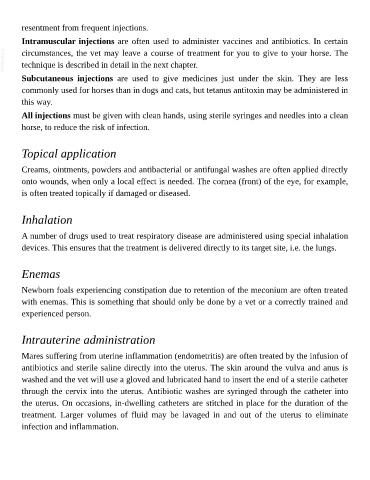Page 1096 - The Veterinary Care of the Horse
P. 1096
resentment from frequent injections.
Intramuscular injections are often used to administer vaccines and antibiotics. In certain
VetBooks.ir circumstances, the vet may leave a course of treatment for you to give to your horse. The
technique is described in detail in the next chapter.
Subcutaneous injections are used to give medicines just under the skin. They are less
commonly used for horses than in dogs and cats, but tetanus antitoxin may be administered in
this way.
All injections must be given with clean hands, using sterile syringes and needles into a clean
horse, to reduce the risk of infection.
Topical application
Creams, ointments, powders and antibacterial or antifungal washes are often applied directly
onto wounds, when only a local effect is needed. The cornea (front) of the eye, for example,
is often treated topically if damaged or diseased.
Inhalation
A number of drugs used to treat respiratory disease are administered using special inhalation
devices. This ensures that the treatment is delivered directly to its target site, i.e. the lungs.
Enemas
Newborn foals experiencing constipation due to retention of the meconium are often treated
with enemas. This is something that should only be done by a vet or a correctly trained and
experienced person.
Intrauterine administration
Mares suffering from uterine inflammation (endometritis) are often treated by the infusion of
antibiotics and sterile saline directly into the uterus. The skin around the vulva and anus is
washed and the vet will use a gloved and lubricated hand to insert the end of a sterile catheter
through the cervix into the uterus. Antibiotic washes are syringed through the catheter into
the uterus. On occasions, in-dwelling catheters are stitched in place for the duration of the
treatment. Larger volumes of fluid may be lavaged in and out of the uterus to eliminate
infection and inflammation.

